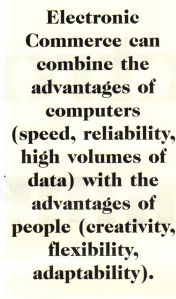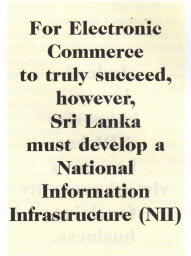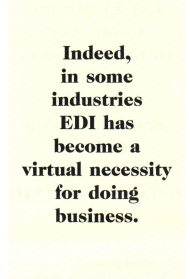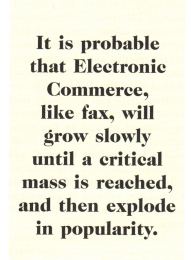The Internet has provided a faster, cheaper, and more reliable platform for communication of business. data within and between commercial entities. 1996 was a landmark year for the development of the World Wide Web in Sri Lanka. There were over a 100 Sri Lankan web sites that were launched in 1996 and an average of 6 to 7 web sites, from across the Sri Lankan spectrum of organisations, are uploaded every month. Using e-mail and the World Wide Web, Sri Lankan organisations are discovering new international audiences for the corporate messages. The next step in this development is to acquire online transaction capabilities that will truly establish Electronic Commerce in Sri Lanka. A development that is slated to come true by mid-1997.

Great distances and multiple time zones are no longer barriers. to business communications; the challenge now is how to respond to and use an ever-increasing flood of data from diverse sources in at timely and effective manner. The stakes are high: vital information from the office next door or the other side of the world may be lost or unnecessarily delayed in the flood.
Many businesses are coping with the data flood by shifting much of their routine data processing and business transactions to automated, electronic information systems. However, differences in information systems require that trading partners frequently translate from one system to another manually, greatly reducing both the speed and the reliability of information exchange. In addition, while standards for Electronic Data Interchange (EDI) enable fast, accurate exchange of routine, relatively simple business transactions between different automated information systems, EDI requires rigid agreements about the structure and meaning of data. These agreements are often expensive, inflexible, and difficult to maintain, especially in a rapidly changing business environment. Electronic Commerce is the evolution of EDI into other types. of data and transactions. An advanced national Electronic Commerce capability will comprise interconnected communication networks; advanced computer hardware and software tools and services; established business transaction. data exchange, interoperability standards; accepted security and privacy provisions; and suitable managerial and cultural practices. This infrastructure will enable diverse and distributed companies throughout the nation to rapidly, flexibly, and securely exchange and, more importantly, use information to drive their business processes. As a result, people who are needed to creatively solve complex business problems can be taken out of the loop of routine data processing
Electronic Commerce Applications

Electronic funds transfer – extending and completing the procurement process by providing buyers the ability to rapidly and cost-effectively make their payments to sellers and shippers with less financial risk and fewer errors, while reducing paper handling and storage.
Government regulatory data interchanges – collecting formatted data from (and returning data to) various communities to enable the government to carry out its mandated responsibilities, e.g… corporations and banking institutions that submit financial reports, and State public health officials who report health statistics and epidemiologic incidents.
Collaborative engineering — providing for early evaluation of engineering designs to ensure manufacturability, reliability, maintainability, etc.. This may involve massive amounts of highly complex engineering data, as well as extensive, non-routine interaction among people.
Enterprise integration
extending integration throughout at company and into other trading partners. Business Process Reengineering is needed to identify business processes which can bet Improved (or eliminated entirely) by improving communicationwithinbyor company outsourcing to other companies. The result is the Virtual Enterprise, which provides vertical integration of companies with their suppliers as well as horizontal integration of segments of a company. Computer-supported collaborative work expanding collaborative activities from engineering into many other business activities, such as supporting joint development of requirements, maintenance documents, etc., within or across companies (e.g., just-in- time inventory control). The intent is to remove the barriers (time, space, information complexity, etc.) that inhibit creative interactions among people.
Electronic Commerce can combine the advantages of computers (speed, reliability, high volumes of data) with the advantages of people (creativity, flexibility, adaptability). Electronic Commerce can enable people to review, analyse, add value, and sell a wide variety of products that are represented electronically, such as reference material, textbooks and training materials, entertainment, and software. Electronic Commerce is not limited only to business transactions it also applies to exchanges of ideas and opinions, as well as the amassing and sorting of information.
The successful extension of Electronic Commerce into these more complex (and rewarding) areas is dependent on the integration of communication, data management, and security services into a ubiquitous, user-friendly, easily accessible national electronic marketplace that encourages and enables the seamless exchange of information for social and business transactions companies for all In sum, Electronic Commerce differs from traditional commerce primarily in the way information is exchanged and processed.
Benefits of Electronic Commerce
Electronic Commerce applications will provide benefits in a number of areas:
1. Reduced costs to buyers from increased competition in procurement as more suppliers are able to compete in an electronically open marketplace;
2. Reduced errors, time, and overhead costs in information processing by eliminating requirements for re-entering data;
3. Reduced costs to suppliers by electronically accessing on-line databases of bid opportunities, online abilities to submit bids, and on-line review of awards;
4. Reduced time to complete business transactions, particularly reduced time from delivery to payment;
5. Creation of new markets through the ability to easily and cheaply reach potential customers;
6. Easier entry into new markets, especially geographically remote markets, as the playing field becomes more level between companies of different size and locations;
7. Better quality of goods as specifications are standardised and competition increases, and better variety of goods through expanded markets and the ability to produce customised goods;
8. Faster time to market as business processes are linked, enabling virtual elimination of time delays between steps and the engineering of each sub-process within the whole process for seemingly seamless processing:
9. Optimisation of resource selection as businesses quickly form cooperative teams to better capabilities, to make use of opportunities, to increase chances of success, to share economic successes more broadly, and to give the customer a mix of capabilities meeting his requirements more exactly. Teaming may happen at either the company or individual level, creating a just-in-time ‘virtual’ resource for delivery of the right human and business resources for a job. In addition, the workforce can be better utilised by freeing skilled labour from routine activities enabling them to focus instead on customer service and more complex duties;
10. Reduced inventories and a related reduction of risk of obsolete inventories as the demand for goods and services are electronically linked through just-in-time inventory and integrated manufacturing techniques.

The implications for Sri Lanka
Electronic Commerce applications will help Sri Lankan companies increase productivity by enabling rapid business transactions, data and information exchanges, organisational and changes. Through the ability to handle tremendous volumes of transactions and the ability to amass, analyse, and control large quantities of specialized data, organisations will be able to improve efficiency and accuracy, and reduce costs, while providing faster, more reliable, and more convenient services.
For Electronic Commerce to truly succeed, however, Sri Lanka must develop a National Information Infrastructure (NII) along the lines of those being developed in the USA, Malaysia and Singapore. Is this too much to ask of a relatively poor country like Sri Lanka? No it is not! The key to infrastructure development is to invite the participation of the private sector. Private sector involvement in building the NII will release much needed state funds for other more urgent expenses. The development of the NII by the private sector must go hand in hand with a set of balanced regulatory measures to ensure the success and long term sustainability of the project. To be truly successful, the development of the NII must be driven by the end users (1.e., the private sector) and it must be free from bureaucratic meddling
Most importantly, in combination with changes in management practices, organizational design, corporate culture and other non- technical advancements, Sri Lankan companies can reengineer their business processes, and then use the National Information Infrastructure (NII) to take greater advantage of the productivity potential of their current and future information technology investments.
Electronic Commerce will increase efficiency by improving human access to information, and increase the need for human judgment based on that information.
The immediate effect will be to enhance the dynamics of competition in the country’s economy. With the ability to perform Electronic Commerce anywhere at anytime, smaller firms will be able to enter and participate at lesser cost and more efficiently in new markets, and larger firms will be able to evaluate, select, and work with other companies more readily than is possible today. In addition, with an advanced NII in place, new ways of doing business and new forms of economic activities will develop, including telecommuting, worldwide research networks, global sourcing arrangements, large-scale development and sharing of databases, new training and education capabilities, faster response innovation systems, disaggregated alliances or networks of companies New and Catching up in some international markets and expanding market share in others are critical to domestic economic growth, as exports will probably continue to be the largest source of added value to the GDP.
Finally, as information and information exchange become more valuable to economic performance, those countries that develop an effective advanced information infrastructure will gain a competitive advantage in global markets. Instead of just chasing low-wages around the globe, as has been the trend in the recent past, companies increasingly will choose to
locate and invest in countries whose infrastructure and highly- skilled workforce are able to handle the rapid and efficient control and dissemination of information and the integration of diverse business operations.

Evidence
In the USA, many companies in several industries have experienced the benefits and realised the need to use Electronic Commerce to survive. Large companies such as Sears, General Motors (GM), and Wal-Mart have championed electronic trading practices for their suppliers. Indeed, in some industries EDI has become a virtual necessity for doing business.
In the 1980’s, Wal-Mart Stores, Inc., experienced explosive growth in sales, rising to number one in the US retail business. Despite its rapid growth, Wal-Mart’s investment of half a billion dollars in computer and satellite communications networks, bar code systems, scanners, and other ‘quick response’ equipment, linking each point-of-sale terminal to distribution centres and headquarters in Bentonville, Arkansas, enabled the company to maintain high service levels and increase sales while preserving one-fourth of the inventory investment. By empowering its individual stores to order directly from suppliers, even overseas, Wal-Mart stores reduced inventory restocking time from an industry average of six weeks to thirty-six hours. Moreover, by tracking every sale to see what was selling and what was not, Wal-Mart was able to keep the stores well-stocked, while maintaining tight inventories and low prices.
In building a brand new facility to manufacture its Saturn cars, General Motors developed an information infrastructure to enable Saturn and its numerous suppliers to operate as one company. Through the implementation of a production scheduling database and the use of electronic data interchange, Saturn and its suppliers reduced overheads in all organisations, increased cooperation, and broke one of the oldest rules in any corporation’s unwritten rule book-treat vendors as adversaries. Located in Spring Hill, Tennessee, the Saturn plant includes an online manufacturing database which is accessible by component suppliers who do not wait for GM to send a purchase order, but simply consult the car maker’s production schedule, included in the database. In this process there is no paper no purchase order and no invoice. After the parts are shipped, the vendor sends an electronic message to Saturn saying, in effect, “These are the parts we have sent you.’ When the box of goods arrive, the receiving clerk scans the bar code printed on it with an electronic wand. The computer can then tell the receiving clerk to what part of the plant the goods should go. The scanning also initiates payment to the vendor.
Over the past decade, the banking and financial industries have invested heavily in automation and networking technologies, to handle and process (electronically) an ever-increasing number of financial transactions. For example, the clearing house for Interbank Payment Systems coordinates daily bank-to-bank transactions worth nearly 82 trillion while the nation’s network of more than 75,000 Automated Teller Machines (ATMs) handles more than 6 billion transactions per year. In addition, one analysis of the New York Stock Exchange suggests that electronic trading saves stock buyers and sellers hundreds of millions of dollars annually. Examples of the effect of Electronic Commerce on specific financial institutions abound. Through the use of information technologies, Visa’s peak capacity for processing credit card transactions grew from 30,000 per day in 1978 to over 1.4 million per day in 1991, while its response time for authorisations dropped from 5 minutes in 1973 to 1.1 seconds in 1991; through the deployment of an ATM network in 1977 Citibank increased its market share from 4 percent to 13.4 percent; by installing a computer-based network to resolve credit card disputes; Mellon Bank reduced its backlog of customer complaints from 5,200 to 2,200, resolving them in 25 days on average (versus 45 days previously).
Through the use of just-in-time inventory control and total quality management practices, Harley Davidson reduced manufacturing cycle time for motorcycle frames from 72 days to just 2, while increasing final product quality from 50 percent to 99 percent; Digital Equipment reduced overall inventory from 16 weeks to 3, while reducing its defect rate from 17 percent to 3 percent; and 3M attained a 70-fold reduction in critical defects, appearance defects, and packaging problems.
Where Are We Now?
Thus, many US companies use Electronic Commerce applications to facilitate internal operations and interact seamlessly with their trading partners. While a wide variety of transactions occur electronically already, the performance of Electronic Commerce applications usually requires highly structured, previously established arrangements and, for the most part, dedicated lines and/or Value- Added-Networks (VANS). The resulting costs and necessary lead times frequently create barriers to investment in, and in the wide- spread use of Electronic Commerce applications by small and medium-sized companies, and inhibit the expansion of Electronic Commerce beyond large companies and their major trading partners.
Electronic Commerce usually happens as a set of evolutionary implementations. The early implementations focus on the introduction of electronic technologies to add functionality and operational effectiveness (i.e., automate business processes) by connecting computers and applications with electronic tools such as bulletin board systems, groupware, databases, e-mail, electronic directories, imaging, and graphics. The second phase moves beyond automation to complete business process reengineering, where major benefits are realised from the integration of the business processes. Business process reengineering, facilitated by Electronic Commerce, eliminates time and distance constraints, leading to double digit or higher annual returns on investment as well as increasing cycle time by an order of magnitude or better. Obtaining Electronic Commerce benefits is more like a journey rather than a destination. With each increase in the efficiency of business processes, new bottlenecks are identified, studied, and overcome yielding a new level of benefits. An improved NII will establish an environment conducive to speeding up this evolution.
The exponential growth of the Internet indicates that connectivity and the use of electronic mail, the World Wide Web interface and file transfers are growing at an enormous rate. In addition, EDI is currently being used by many individuals and organizations to automate simple business decisions and financial transactions. The problem is that these two applications, Internet and EDI, are currently considered two different technical domains. To a great extent, the EDI concept preceded the development of the Internet as we know it and most EDI applications use antiquated X.25 or X.400 (packet switched) technology while the explosive growth of the Internet would not have happened if not for the robustness and flexibility of the technology commonly known as TCP/IP. The global trend is to move away from packet switched networks to open networks on a TCP/IP platform. The Intranet, is in effect a recent permutation of EDI application using Internet technology. The Internet’s multi-platform, open architecture and use of existing telecom infrastructure reduces costly overheads by eliminating the need for extensive infrastructure investment at the network and user levels.
Where Do We Want to Be?
The ultimate goal of Electronic Commerce is the creation of a national electronic marketplace which is secure, open, affordable, easy to access, and easy to use. To make an advanced NII for Electronic Commerce a reality, individuals and organisations must continue to increase their use of and familiarity with networked communications services and tools, such as the Internet, as quickly as makes financial sense. A fully scaled, comprehensive national Electronic Commerce capability, however, involves much more than the reduction of paper- work and the speeding of decision making information for business and government transactions. In particular, the creation of an advanced infrastructure that can support national Electronic Commerce requires solutions to many technical, legal, security, financial and regulatory barriers, as well as the widespread adoption and use of a variety of technical standards for communication, information processing, and security.
To this end, the government must promote the development of a private sector funded and driven National Information Infrastructure programme that will capitalise on the rapid development of the Internet industry in Sri Lanka to good effect. All that is required is to set up a high-speed wireless backbone to supplement and complement the existing and planned telecom infrastructure. Once that backbone is in place, Sri Lanka will have a NII that can provide the foundation for an electronic marketplace. A marketplace that in the best traditions of the private sector, will fund future enhancement and development of the National Information Infrastructure.
How Are We Going to Get There?
It is probable that Electronic Commerce, like fax, will grow slowly until a critical mass is reached, and then explode in popularity. How can we reach a critical mass as quickly as possible while ensuring that the transition from traditional commerce activities to Electronic Commerce activities is as smooth as possible? The following paragraphs represent only a starting point for formulating the key issues and questions, and for initiating the key actions and policies that are needed to facilitate the development of the Electronic Commerce application as part of the NII. The full range of issues described in this article must be addressed to realise the full potential of Electronic Commerce.

Issues and Questions to be Addressed
Government and industry cannot accept Electronic Commerce unless electronic transactions are secure. There are clear requirements for authentication of the source of a transaction, verification of the integrity of the transaction, prevention of disclosure of the transaction to unauthorised users, and verification of receipt of the transaction by the intended trading partner. Is the current work in computer security services adequate for timely resolution of these technical issues, or should the direction of work be changed or the level of effort increased? What organizations and mechanisms are needed to ensure that government and industry can jointly address security-related issues?
Electronic Commerce application will require the interoperation of communications, data management, and security services. These services will be provided by many different companies, including Value-Added-Networks, systems integrators, hardware vendors, and software vendors. Given this diversity, how can government and industry ensure that Electronic Commerce will be reliable, and that the components can be assembled, maintained, and upgraded at reasonable cost? We must develop technologies, measurement tools, testing services, interoperability demonstrations, etc., to ensure that components. satisfy the current and future requirements of government and industry. Should the Internet Service Providers be tasked to lead this effort? What other organisations can lead or contribute to this effort? What actions are needed to ensure appropriate funding?
Successful resolution of technical issues will be insufficient to ensure the widespread use of Electronic Commerce; economic, cultural, regulatory, and legal barriers to Electronic Commerce must be identified and removed. For example, how can government and industry ensure that Electronic Commerce will be viewed positively by workers? What incentives can be provided so that workers will share in the benefits of Electronic Commerce? How can government and industry establish realistic business cases and success stories to encourage potential users and providers of Electronic Commerce hardware, software, and services? Are the benefits discussed in this article adequate, or are additional incentives required? Should government and industry create a joint task force to identify the most critical barriers and incentives and identify or create appropriate organisations to remove those barriers and provide those incentives? What actions are needed to ensure appropriate funding for the joint task force and for the organisations that it will identify or create?
What can we learn from the efforts of other countries?


